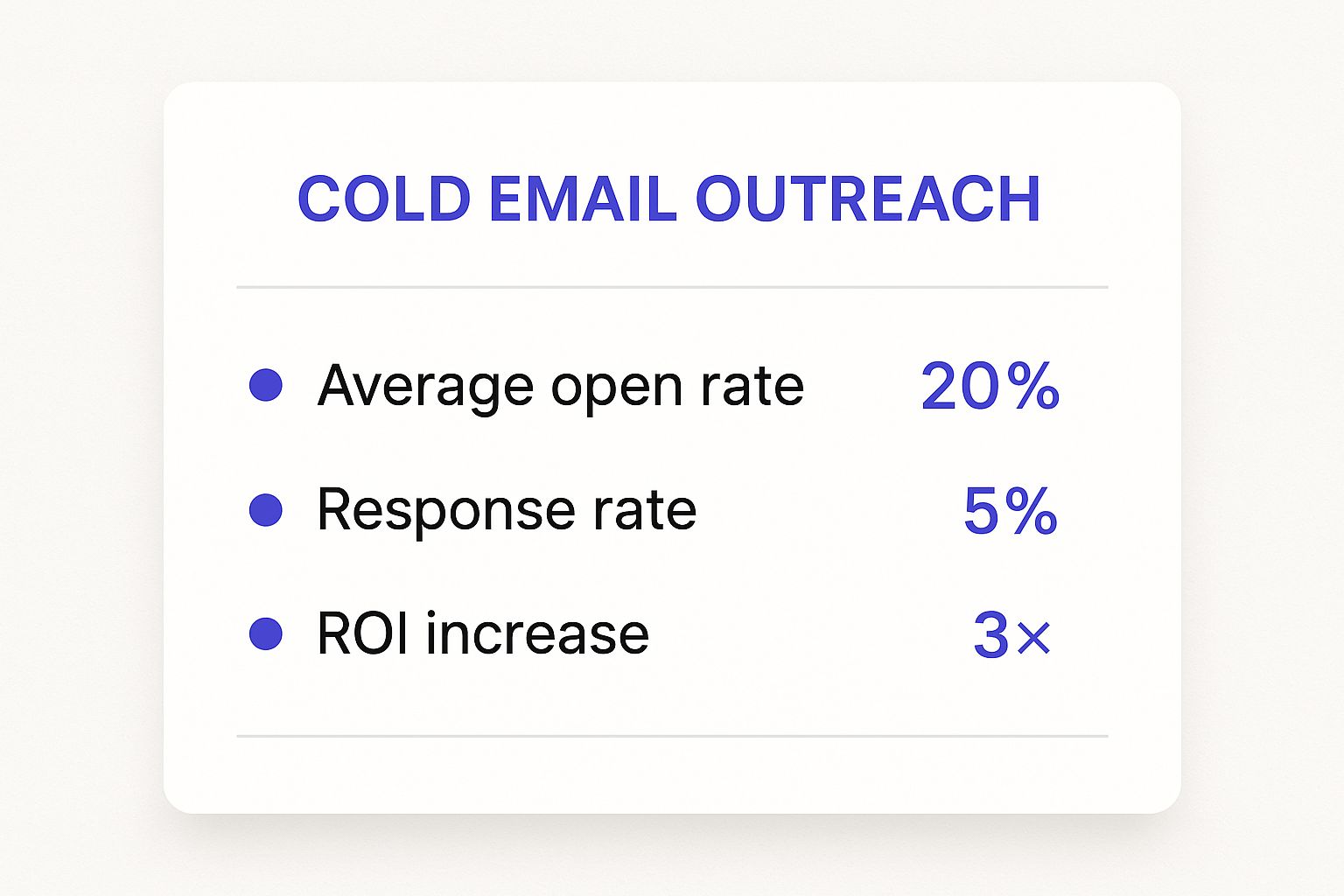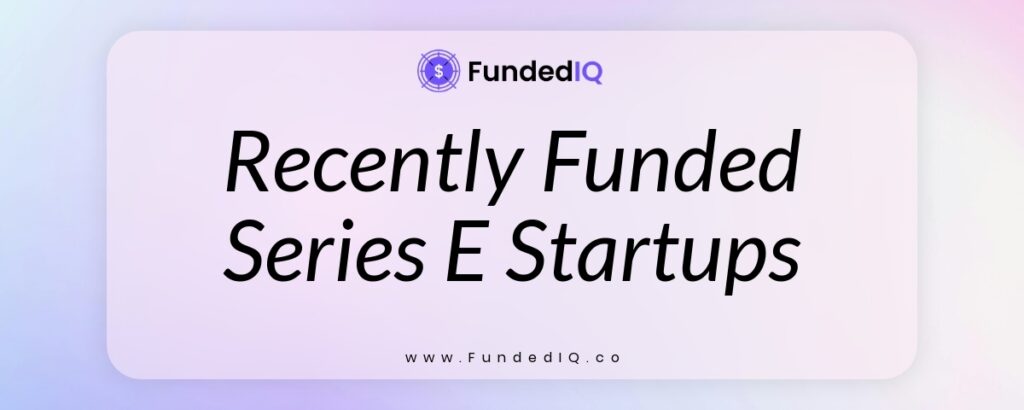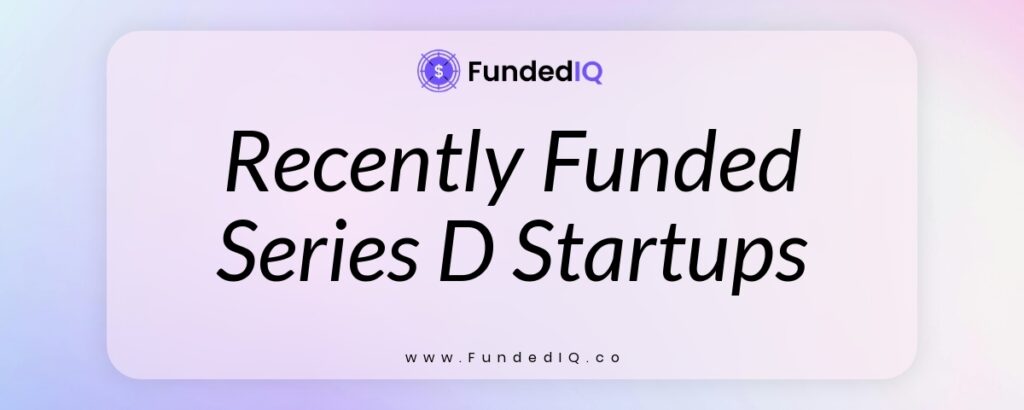Mastering Cold Email Outreach That Converts

Let's get one thing straight: cold email outreach isn't just about sending emails to strangers. It’s the art of starting a valuable conversation with a potential customer you’ve never met, all with the goal of sparking a real business opportunity. Done right, it's one of the most powerful and cost-effective B2B client acquisition channels. A 2023 study found that cold email outreach can deliver an ROI of up to $36 for every $1 spent, making it a powerhouse for connecting with high-intent startup leads.
Why Your Cold Emails Are Getting Ignored
Ever feel like you’re sending emails into a black hole? You're not alone. Most cold outreach fails, and it's not because email is dead. The real problem is an outdated, brute-force approach.
Too many people are still playing a numbers game—blasting generic templates to massive, untargeted lists and just hoping for a miracle. That's not a strategy; it's a surefire way to get your messages ignored, deleted, or worse, have your domain's sending reputation damaged.
The secret isn't to send more emails. It's to send smarter ones. The shift is from a volume-based mindset to a value-driven one. Your outreach needs to feel less like a hard sales pitch and more like the beginning of a genuine conversation. You have to prove you understand their world before you ask for a minute of their time.
The Modern Approach to Cold Email
This guide is built on three pillars that will help your outreach cut through the noise and actually get noticed:
- High-Intent Prospecting: Forget scraping random contacts. We’re talking about finding startups that are showing clear, undeniable buying signals, like recent funding rounds or key executive hires.
- Hyper-Relevant Messaging: This is where you craft emails so personalized they feel like they could only have been written for one person. A practical example is referencing a specific point they made in a recent podcast interview.
- Value-Added Follow-Ups: No more "just bumping this up" emails. Your follow-up sequence should offer something new and valuable with every single touchpoint, like sharing a relevant case study or an insightful industry report.
The real difference between spam and a successful cold email comes down to one word: relevance. A relevant email shows you’ve done your homework and respect the recipient's time, which instantly separates you from 99% of the emails in their inbox.
Let's look at the numbers. Cold email is still the king of B2B communication; a whopping 61% of decision-makers prefer it over any other channel. But here's the catch: the biggest reason they don't respond is a lack of relevance, a complaint from 71% of recipients. After that, it's impersonality (43%) and a lack of trust (36%). If you're curious, you can dig into the full findings on cold email performance and see just how critical personalization has become.
To succeed today, you have to move past the old spray-and-pray tactics. Here’s a quick breakdown of what separates the pros from the spammers.
Modern Outreach vs. Old-School Spam
| Element | The Ineffective 'Spam' Approach | The Modern, Effective Strategy |
|---|---|---|
| Targeting | Massive, generic lists scraped from anywhere. | Highly-curated lists based on specific buying signals. |
| Messaging | One-size-fits-all template focused on "me, me, me." | Hyper-personalized message focused on the prospect's needs. |
| Goal | Get a sale or book a demo immediately. | Start a genuine conversation and build a relationship. |
| Follow-Up | Annoying "just checking in" bumps. | Value-driven touches that offer new insights or resources. |
This shift in thinking is non-negotiable if you want to see real results.
This data really hammers home what truly matters in a cold outreach campaign.

As you can see, open rates are just the starting line. The real wins are measured in your reply rate and, ultimately, the tangible return on investment your efforts bring in.
Building a Prospect List That Actually Responds

Let's be honest: even the most brilliantly written cold email is just spam if it lands in the wrong inbox. The absolute foundation of any successful outreach campaign isn't your subject line or your call-to-action—it's the quality of your prospect list.
The whole game is about shifting your focus from quantity to quality. Forget blasting thousands of random contacts. I've seen firsthand that a hand-picked list of 50 highly-qualified prospects will consistently crush a generic list of 5,000. The secret is to build your list around intent, not just demographics. A practical insight here is that the conversion rate from a hyper-targeted list can be 5-10 times higher than that of a broad, non-specific list.
We're looking for companies that don't just fit your basic criteria but are also dropping hints that they need your solution right now.
Defining Your Ideal Customer Profile
A truly effective Ideal Customer Profile (ICP) goes way beyond the basics. It's about combining different data points to paint a crystal-clear picture of your perfect-fit customer.
- Firmographics: This is your starting point. Think industry, company size, annual revenue, and where they're located. A good example is a SaaS company targeting B2B tech startups that have between 50-200 employees and have raised a Seed or Series A round.
- Technographics: This is where it gets interesting—what tools are they already using? Knowing a company runs on HubSpot or Salesforce can be a game-changer. For example, if you sell a HubSpot integration, that piece of data is pure gold and lets you tailor your pitch to their existing workflow.
These criteria give you a solid base, but the real power comes from layering on what we call "buying signals."
Identifying Actionable Buying Signals
Buying signals are the triggers that turn a good-fit prospect into a high-intent lead. They’re real-world events that basically scream, "We have a problem you can solve!"
Think about it: a startup that just announced a Series A funding round isn't just sitting on that cash. They're about to pour it into growth. That's your cue. Tools like Crunchbase for tracking funding or LinkedIn Sales Navigator for monitoring executive hires are essential for catching these opportunities as they happen.
Here are some of the most powerful buying signals I always look for:
- Recent Funding: Fresh capital almost always means a company is ready to spend on new tools and services to scale up. For example, a company that just raised $5M will likely invest in sales, marketing, and HR tech within the next 3-6 months.
- Key Hires: When a startup hires its first-ever Head of Sales, you can bet they're getting serious about building out their revenue engine. This is a prime time to reach out with solutions for sales training, CRM implementation, or lead generation.
- New Product Launches: A new product brings new challenges in marketing, sales, and operations—all areas where you might be able to help.
Your prospect list shouldn't be a random collection of names. It should be a curated portfolio of opportunities. Every single contact needs to represent a company with a problem you can solve, backed by clear evidence they're ready to listen.
One final, non-negotiable step: email verification. Firing off emails to bad addresses leads to a high bounce rate (ideally, keep it under 3%), which is a massive red flag for email providers and can wreck your domain's reputation. Always run your list through a tool like Hunter or ZeroBounce to keep it clean and ensure your messages actually get delivered.
For agencies wanting to go even deeper on this, our guide on effective lead generation for agencies breaks down more advanced strategies for pinpointing these high-value opportunities.
Writing Emails People Actually Want to Read
So you've built a list of high-intent prospects.You've done the hard work and built a solid list of high-intent prospects. Now comes the part where most outreach campaigns completely fall apart: writing the actual email. A great list deserves so much more than a generic template. What you really need is a repeatable framework for writing emails that get opened, read, and most importantly, answered.
Let's get one thing straight: forget the long, self-centered pitches. An effective cold email is short, relevant, and laser-focused, ideally between 50 and 125 words. It all boils down to three make-or-break components: the subject line, the opening hook, and the call-to-action (CTA). If you nail these three, you turn cold outreach from a guessing game into a reliable science.
Your Subject Line: The First Impression
Your subject line has one job and one job only: to earn the open without sounding like cheap clickbait. People are naturally skeptical of emails from strangers, so you need to lean on clarity and curiosity. A little bit of personalization goes a long way here—in fact, personalized subject lines can bump up open rates by a whopping 22%.
Stay away from the tired, salesy phrases everyone sees a dozen times a day, like "Quick Question" or "Introductory Offer." Your goal is to be professional, but intriguing.
I've seen a few formats that consistently cut through the noise:
- The Connection:
[Their Company] <> [Your Company](e.g., "Acme Corp <> FundedIQ"). It's professional, creates an immediate visual connection, and makes them wonder about a potential partnership. - The Specific Idea:
Idea for [Specific Goal](e.g., "Idea for scaling your sales team"). This immediately signals that you've thought about their business, not just your own. - The Mutual Connection:
[Mutual Connection Name] suggested I reach out. This is gold. If you have a legitimate referral, it’s the most powerful subject line you can use, often leading to open rates above 80%.
The Hook: Prove You Did Your Homework
Once they open the email, the clock is ticking. You have maybe three seconds to grab their attention. Your opening line is your one shot to prove this isn't another automated email blast. This is where you show you’ve done your homework.
Reference something specific and recent that shows you have a genuine interest in them or their company. For example, check their LinkedIn profile for recent posts, company news for press releases, or listen to a podcast they were on.
The perfect opening line makes the prospect think, "This person gets it." It instantly builds rapport and separates you from the 95% of outreach that is completely impersonal.
A generic opener like, "I saw you're the Head of Marketing at Acme Corp…" is a complete waste of prime real estate. It tells them nothing they don't already know.
Before (Generic):"Hi Sarah, I came across your company and was impressed by your work in the SaaS space."
After (Specific & Relevant):"Hi Sarah, I just listened to your interview on the SaaS Breakthrough podcast—your insights on product-led growth were fantastic."
See the difference? This simple change transforms the entire dynamic. It’s no longer a cold pitch; it’s the start of a warm conversation.
The Call-to-Action: Make It Easy to Say "Yes"
Finally, we get to the call-to-action (CTA). This is where you gently guide them to the next step. The single biggest mistake I see people make is asking for way too much, way too soon. A request for a "30-minute demo" is a huge commitment to ask of a complete stranger.
Instead, your CTA should be a low-friction, interest-based question. You're not trying to book a meeting right away. The real goal is to get a simple "yes" or "no" to see if there's any interest at all. This approach often doubles reply rates compared to high-commitment asks.
Before (High-Friction):"Are you free for a 15-minute call next week to discuss this further?"
After (Low-Friction):"Curious to see how this works for companies like yours?"
This approach feels less demanding and makes it incredibly easy for them to reply. When you combine a strong, personalized message with the right technology, you create a system that consistently starts valuable conversations. You can discover more powerful strategies by exploring a curated list of top-tier B2B lead generation tools that perfectly complement this kind of thoughtful outreach.
Designing a Follow-Up Sequence That Adds Value

Let's get one thing straight about cold email outreach: sending one perfect email and crossing your fingers is a recipe for failure. The real breakthroughs—and most of your positive replies—will come from a thoughtful, persistent follow-up sequence. In fact, data shows that over 50% of replies come from a follow-up email, not the initial one.
The trick is to ditch the lazy "just bumping this up" approach. Every single message you send has to bring something new to the table. Instead of just poking them for a response, your mission is to offer something genuinely helpful that builds your credibility and keeps you on their radar.
When you do this right, your follow-ups stop being an annoyance and start feeling like a welcome, professional touchpoint. Each email is another opportunity to prove you understand their world and have something valuable to offer.
Creating a Value-Driven Cadence
A solid, effective follow-up sequence doesn't have to be complicated. I've found that a simple, three-step cadence, spaced out over a week or two, works wonders. It gives you multiple chances to connect without turning into a pest.
Here’s a proven 3-step cadence you can steal:
- Follow-Up 1 (3-4 days later): Offer a Relevant Resource. Your first follow-up is the perfect time to share something tangible. Don't just rehash your first email. Instead, link to a specific case study showing how you helped a company just like theirs solve a problem you already mentioned. Example: "Thought you might find this case study on how [Similar Company] boosted their SQLs by 30% useful."
- Follow-Up 2 (4-5 days later): Share an Insight. Next, pivot to education. Send a link to a blog post you wrote that digs into a common industry pain point, or maybe share a compelling article from a trusted source that connects to their goals. Example: "Saw this article in TechCrunch about [Industry Trend] and immediately thought of your team at [Company Name]."
- Follow-Up 3 (5-7 days later): The Polite Break-Up. Still no response? It's time for the final, polite closing email. This message signals that you won't be reaching out again, which often creates a little bit of urgency and can prompt that last-minute reply. Example: "If the timing isn't right, no problem at all. I'll close out your file for now to avoid cluttering your inbox."
The point of a follow-up isn't to pester; it's to prove your value over time. Think of each message as a small gift—an insight, a resource, or a new idea—that makes their day a little bit better.
The data backs this up, time and time again. Campaigns with follow-ups are 2 to 3 times more likely to get a response than those with just a single email. That said, I'd advise against sending more than three follow-ups to avoid burning your list. You can dig into more cold email statistics and best practices to see just how critical this is.
Automating the Schedule While Keeping It Personal
Trying to manually track who needs a follow-up and when is a one-way ticket to chaos. This is where automation tools become your best friend. Modern outreach platforms let you build and schedule your entire sequence ahead of time, firing off the next email only if a prospect hasn't replied.
But here’s the most important part: while the timing is automated, the content must always feel personal. Use custom fields and snippets (like {{firstName}}, {{companyName}}, and {{customHook}}) to make sure every follow-up still reads like a one-to-one message. For a closer look at the tech, check out our guide on the best lead generation automation tools that can manage this for you.
This approach frees you up to focus on what actually grows your business: having meaningful conversations with the high-intent leads who respond.
Measuring What Matters to Improve Performance

If you can't measure it, you can't improve it. It’s an old saying, but it’s the absolute truth in cold email. Too many people get hung up on vanity metrics. Sure, a high open rate feels good, but it doesn't pay the bills. If no one is actually replying, those opens are just noise.
To really get a grip on your campaign's health, you have to look at the numbers that signal real engagement and intent. These are the metrics that tell you if your message is actually landing and pushing prospects to act. A good benchmark for a highly personalized campaign is a 50-70% open rate and an 8-15% reply rate.
- Reply Rate: This is your north star at the top of the funnel. It’s the raw percentage of people who cared enough about your email to actually hit reply. Simple, but powerful.
- Positive Response Rate: Now we're getting warmer. This metric filters out all the "no thanks" or "unsubscribe" replies and tells you how many prospects are genuinely interested in what you have to say. This should be your primary KPI for email copy effectiveness.
- Meetings Booked: This is where the rubber meets the road. It’s the most direct indicator that your outreach is generating legitimate sales opportunities and feeding your pipeline.
At the end of the day, it all comes down to conversion. While every industry is different, the average cold email conversion rate hovers around 0.7%. To put that in perspective, you can expect to close roughly one new customer for every 142 cold emails you send. You can find more data on cold email conversion rates over on breakcold.com.
A Practical Guide to A/B Testing
So, how do you actually improve those numbers? The most reliable method I've found is systematic A/B testing. It takes the guesswork out of the equation and lets the data tell you what your audience really wants. The golden rule here is to test one thing at a time. Otherwise, you'll never know which change actually made the difference.
I always recommend starting with the highest-impact elements first. Your subject line is the perfect candidate, since it has a massive influence on your open rate and sets the stage for the entire conversation.
Here's a real-world example. You could pit a connection-based subject line against one that's focused on a clear benefit:
- Version A (Connection):
[Their Company] <> FundedIQ - Version B (Benefit):
Idea for scaling [Their Company]'s lead flow
Make sure you send each version to a large enough sample size to get meaningful data. A good rule of thumb is at least 100 contacts per version.
Don't stop at subject lines. Systematically test your opening hooks, your value propositions, and especially your call-to-action. Small changes, like asking an interest-based question versus requesting a meeting, can lead to huge lifts in your reply rate.
Once the test is complete, dive into the results. Which version drove more opens, replies, and—most importantly—positive responses? Take the winner, make it your new control (your "A" version), and then pick another element to test.
This constant cycle of testing, learning, and iterating is what separates good campaigns from great ones. It's the engine that will consistently drive your performance forward.
Answering Your Top Cold Email Questions
Even with the best strategy in hand, questions always pop up once you get into the nitty-gritty of cold email outreach. Let's walk through some of the most common hurdles I see people face, so you can move forward with total confidence.
How Many Cold Emails Should I Really Be Sending Every Day?
There's no magic number here, and frankly, anyone who gives you one is guessing. The real answer is to focus on quality over sheer volume.
If you’re doing your homework and crafting highly personalized messages for each prospect, sending 20-50 thoughtful emails per day is an impressive and sustainable pace. This allows for deep research on each prospect, which is what drives high reply rates. It gives you enough time to make every single one count.
On the other hand, if your outreach is a bit more templatized, you might be able to push that to 100-200 emails daily. But be careful. You have to watch your engagement rates like a hawk. If your reply rate starts to drop, you're likely sacrificing personalization for speed, and it’s time to scale back.
The most critical thing to remember? Your email provider's limits. Most platforms like Google or Microsoft cap new accounts at around 150-200 emails per day. The smartest move is to start slow, warm up your account by sending 10-20 emails per day for two weeks, and gradually increase your volume. This is the best way to protect your domain reputation for the long haul.
So, When Is the Absolute Best Time and Day to Send?
You've probably seen the studies that say Tuesday at 10 AM is the "golden hour." While that's a decent starting point, the truth is a lot more nuanced. It all comes down to your specific audience. A startup founder's inbox habits are worlds away from a retail store manager's.
The only data that truly matters is your own. Don't blindly follow generic advice. The best time to send is when your audience is actually checking their email.
So, how do you figure that out? You test. Treat your send time just like you'd test a subject line. Send batches at different times and on different days of the week. For example, send to 100 prospects on Tuesday at 10 AM and another 100 on Thursday at 2 PM. Then, dig into your analytics. The open and reply rates will tell you everything you need to know. Many modern outreach tools can even analyze this for you and pinpoint the optimal windows based on your campaign’s performance.
How Do I Keep My Emails From Landing in Spam?
Getting your emails into the primary inbox—what we call deliverability—is non-negotiable. If you mess this up, nothing else matters. It boils down to a mix of technical setup and smart sending practices.
Here’s your checklist:
- Authenticate Your Domain: This is the boring but essential technical stuff. You need to properly set up your SPF, DKIM, and DMARC records. Think of them as a digital passport that proves to inbox providers that your emails are legitimate. Most domain hosts have simple guides for this.
- Keep Your List Squeaky Clean: Before you send a single email, run your prospect list through a verification tool. This scrubs out invalid and inactive addresses. A high bounce rate (above 5%) is a massive red flag for spam filters and can get your domain blacklisted fast.
- Write Like a Person, Not a Robot: Spammy trigger words ("free," "sale," "guarantee"), all caps, and a ton of links are obvious giveaways. The best defense is to write a genuine, personalized message. An email that’s clearly researched and written for one specific person is far less likely to be flagged by an algorithm or a human.
Ready to stop searching for leads and start connecting with them? FundedIQ delivers a monthly, hand-curated list of recently funded startups, complete with verified decision-maker contacts. Skip the guesswork and get access to high-intent prospects today at fundediq.co.






